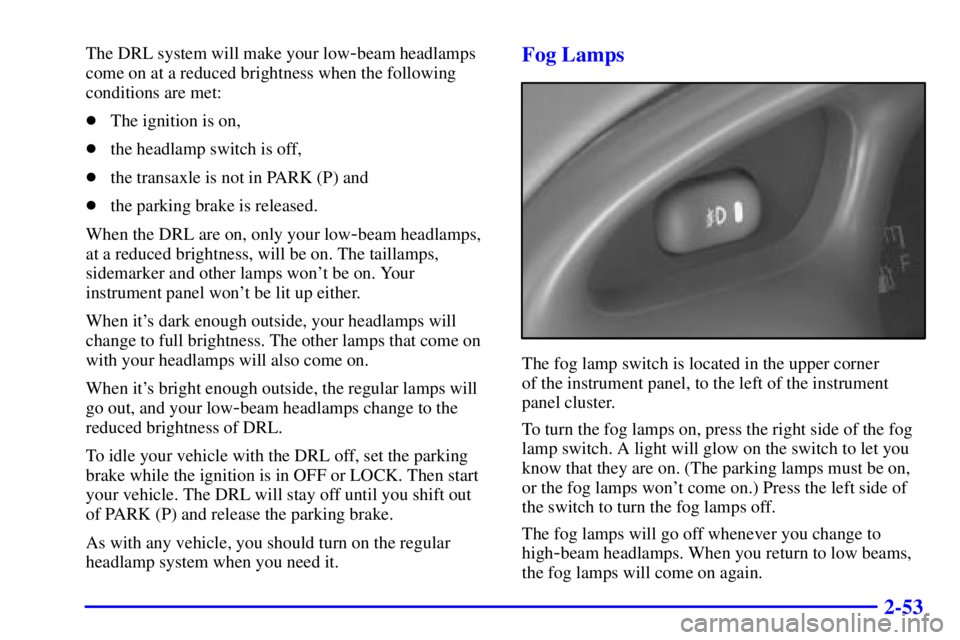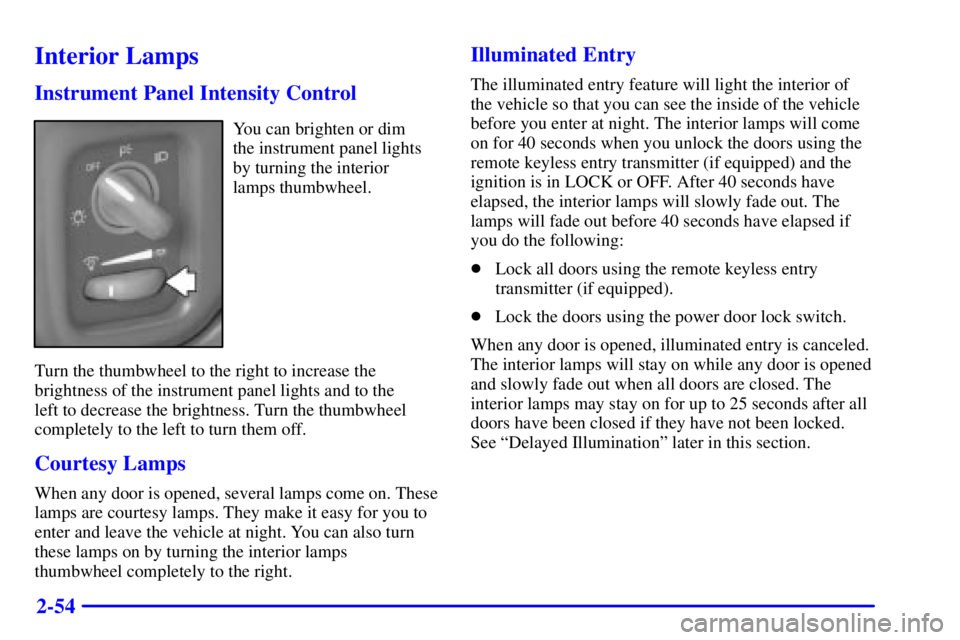Page 107 of 373

2-38
Make sure the shift lever is fully in PARK (P) before
starting the engine. The vehicle has an automatic
transaxle shift lock control system. You must fully apply
the regular brakes before you can shift from PARK (P)
when the ignition is in RUN. If you cannot shift out of
PARK (P), ease pressure on the shift lever by pushing it
all the way into PARK (P) while keeping the brake pedal
pushed down. Release the shift lever button. Then move
the shift lever out of PARK (P), being sure to press the
shift lever button. See ªShifting Out of PARK (P)º in
the Index.
REVERSE (R): Use this gear to back up.
NOTICE:
Shifting to REVERSE (R) while the vehicle is
moving forward could damage the transaxle.
Shift to REVERSE (R) only after the vehicle
is stopped.
To rock the vehicle back and forth to get out of snow,
ice or sand without damaging the transaxle, see ªStuck:
In Sand, Mud, Ice or Snowº in the Index.NEUTRAL (N): In this position, the engine doesn't
connect with the wheels. To restart when you're
already moving, use NEUTRAL (N) only. Also, use
NEUTRAL (N) when the vehicle is being towed.
CAUTION:
Shifting out of PARK (P) or NEUTRAL (N) while
your engine is ªracingº (running at high speed) is
dangerous. Unless your foot is firmly on the
brake pedal, your vehicle could move very
rapidly. You could lose control and hit people or
objects. Don't shift out of PARK (P) or
NEUTRAL (N) while your engine is racing.
NOTICE:
Damage to your transaxle caused by shifting out
of PARK (P) or NEUTRAL (N) with the engine
racing isn't covered by your warranty.
Page 111 of 373
2-42
Shifting Into PARK (P)
CAUTION:
It can be dangerous to get out of your vehicle if
the shift lever is not fully in PARK (P) with the
parking brake firmly set. Your vehicle can roll.
If you have left the engine running, the vehicle
can move suddenly. You or others could be
injured. To be sure your vehicle won't move,
even when you're on fairly level ground, use
the steps that follow. If you're pulling a trailer,
see ªTowing a Trailerº in the Index.
1. Hold the brake pedal down with your right foot and
set the parking brake.2. Move the shift lever into PARK (P) position like this:�Press in and hold the shift lever button, located
on the front of the shift lever.
�Push the shift lever all the way toward the front
of the vehicle.
3. Turn the ignition key to LOCK.
4. Remove the key and take it with you. If you can
leave the vehicle with the ignition key in your hand,
the vehicle is in PARK (P).
Page 113 of 373
2-44
Shifting Out of PARK (P)
Your vehicle has an automatic transaxle shift lock
control system. You must fully apply your regular
brakes before you can shift from PARK (P) when the
ignition is in RUN. See ªAutomatic Transaxle
Operationº in the Index.
If you cannot shift out of PARK (P), ease pressure on
the shift lever by pushing it all the way into PARK (P)
while keeping the brake pedal pushed down. Release the
shift lever button. Then move the shift lever out of
PARK (P), being sure to press the shift lever button.
Parking Over Things That Burn
CAUTION:
Things that can burn could touch hot exhaust
parts under your vehicle and ignite. Don't park
over papers, leaves, dry grass or other things
that can burn.
Page 120 of 373

2-51
Reducing Speed While Using Cruise Control
There are two ways to reduce your speed while using
cruise control:
�Push in the SET button until you reach the lower
speed you want, then release it.
�To slow down in very small amounts, push the SET
button briefly. Each time you do this, you'll go about
1 mph (1.6 km/h) slower.
Passing Another Vehicle While Using Cruise Control
Use the accelerator pedal to increase your speed. When
you take your foot off the pedal, the vehicle will slow
down to the cruise control speed you set earlier.Using Cruise Control on Hills
How well the cruise control will work on hills depends
upon your speed, load and the steepness of the hills.
When going up steep hills, you may have to step on the
accelerator pedal to maintain your speed. When going
downhill, you may have to brake or shift to a lower gear
to keep your speed down. Of course, applying the brake
takes you out of cruise control. Many drivers find this to
be too much trouble and don't use cruise control on
steep hills.
Ending Cruise Control
There are two ways to turn off the cruise control:
�Step lightly on the brake pedal, or
�move the cruise switch to OFF.
Erasing Cruise Speed Memory
When you turn off the cruise control or the ignition, or
shift into PARK (P) or NEUTRAL (N), the cruise
control set speed memory is erased.
Page 121 of 373

2-52
Exterior Lamps
The lamp controls are located on the lower left side of
the instrument panel, to the left of the steering wheel.
They control the following systems:
�Headlamps
�Taillamps
�Parking Lamps
�License Lamps�Sidemarker Lamps
�Instrument Panel Lights
�Courtesy Lamps
: Turn the knob to this symbol to turn on the
headlamps and other operating lamps.
: Turn the knob to this symbol to turn on
the parking and other operating lamps without
the headlamps.
Turn the knob to OFF to turn off the lamps.
A warning chime will sound if you open the driver's
door when you turn the ignition switch to LOCK or
ACCESSORY with the lamps on.
Daytime Running Lamps / Automatic
Headlamp Control
Daytime Running Lamps (DRL) can make it easier for
others to see the front of your vehicle during the day.
DRL can be helpful in many different driving
conditions, but they can be especially helpful in the
short periods after dawn and before sunset. Fully
functional daytime running lights are required on all
vehicles first sold in Canada.
A light sensor on top of the instrument panel makes the
DRL work, so be sure it isn't covered.
Page 122 of 373

2-53
The DRL system will make your low-beam headlamps
come on at a reduced brightness when the following
conditions are met:
�The ignition is on,
�the headlamp switch is off,
�the transaxle is not in PARK (P) and
�the parking brake is released.
When the DRL are on, only your low
-beam headlamps,
at a reduced brightness, will be on. The taillamps,
sidemarker and other lamps won't be on. Your
instrument panel won't be lit up either.
When it's dark enough outside, your headlamps will
change to full brightness. The other lamps that come on
with your headlamps will also come on.
When it's bright enough outside, the regular lamps will
go out, and your low
-beam headlamps change to the
reduced brightness of DRL.
To idle your vehicle with the DRL off, set the parking
brake while the ignition is in OFF or LOCK. Then start
your vehicle. The DRL will stay off until you shift out
of PARK (P) and release the parking brake.
As with any vehicle, you should turn on the regular
headlamp system when you need it.
Fog Lamps
The fog lamp switch is located in the upper corner
of the instrument panel, to the left of the instrument
panel cluster.
To turn the fog lamps on, press the right side of the fog
lamp switch. A light will glow on the switch to let you
know that they are on. (The parking lamps must be on,
or the fog lamps won't come on.) Press the left side of
the switch to turn the fog lamps off.
The fog lamps will go off whenever you change to
high
-beam headlamps. When you return to low beams,
the fog lamps will come on again.
Page 123 of 373

2-54
Interior Lamps
Instrument Panel Intensity Control
You can brighten or dim
the instrument panel lights
by turning the interior
lamps thumbwheel.
Turn the thumbwheel to the right to increase the
brightness of the instrument panel lights and to the
left to decrease the brightness. Turn the thumbwheel
completely to the left to turn them off.
Courtesy Lamps
When any door is opened, several lamps come on. These
lamps are courtesy lamps. They make it easy for you to
enter and leave the vehicle at night. You can also turn
these lamps on by turning the interior lamps
thumbwheel completely to the right.
Illuminated Entry
The illuminated entry feature will light the interior of
the vehicle so that you can see the inside of the vehicle
before you enter at night. The interior lamps will come
on for 40 seconds when you unlock the doors using the
remote keyless entry transmitter (if equipped) and the
ignition is in LOCK or OFF. After 40 seconds have
elapsed, the interior lamps will slowly fade out. The
lamps will fade out before 40 seconds have elapsed if
you do the following:
�Lock all doors using the remote keyless entry
transmitter (if equipped).
�Lock the doors using the power door lock switch.
When any door is opened, illuminated entry is canceled.
The interior lamps will stay on while any door is opened
and slowly fade out when all doors are closed. The
interior lamps may stay on for up to 25 seconds after all
doors have been closed if they have not been locked.
See ªDelayed Illuminationº later in this section.
Page 124 of 373

2-55 Delayed Illumination
The delayed illumination feature will continue to light
the interior of the vehicle for 25 seconds after all the
doors have been closed so that you can find the ignition
and buckle the seat belt at night. Delayed illumination
will not occur while the ignition is in RUN or
ACCESSORY. After 25 seconds have elapsed, the
interior lamps will slowly fade out. The lamps will
fade out before the 25 seconds have elapsed if you do
the following:
�Turn the ignition to RUN or ACCESSORY.
�Lock all doors using the remote keyless entry
transmitter (if equipped).
�Lock the doors using the power door lock switch.
To turn delayed illumination feature off or on, see
ªLocks and Lighting Choicesº in the Index.
Delayed Exit Lighting
For exiting the vehicle at night, the vehicle is equipped
with the delayed exit lighting feature. The interior lamps
will illuminate for up to 25 seconds when you remove
the key from the ignition. After 25 seconds have
elapsed, the interior lamps will slowly fade out.
The lamps will fade out before the 25 seconds have
elapsed if you:
�Insert the key and turn the ignition to RUN
or ACCESSORY.
�Lock all doors using the remote keyless entry
transmitter (if equipped).
�Lock the doors using the power door lock switch.
When any door is opened, delayed exit lighting is
canceled. The interior lamps will stay on while any door
is opened and will slowly fade out when all the doors
are closed. The interior lamps may stay on for up to
25 seconds after all the doors have been closed if they
have not been locked. See ªDelayed Illuminationº
earlier in this section.
To turn the delayed exit lighting feature off or on,
see ªLocks and Lighting Choicesº in the Index.